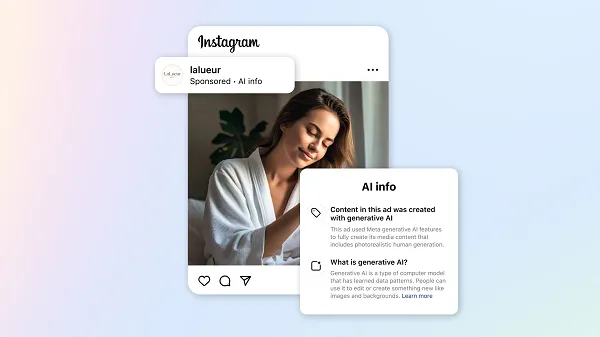Meta Reveals Enhanced AI Transparency Guidelines

Meta’s Push for AI Transparency
Meta, the parent company of Facebook and Instagram, is making efforts to be more transparent about the use of generative AI tools in image creation. This move comes as the company encourages users to engage with its AI features. By integrating new labeling practices in advertisements, Meta aims to help users differentiate between genuine content and AI-generated images.
Introduction of New Labeling Practices
Last year, Meta began introducing labels for ads created with its generative AI tools. The company has recently shared updates on its labeling techniques to enhance transparency. According to Meta, these labels are intended to inform users when images or videos have been produced or significantly altered using its AI technologies.
Meta’s Labeling Description:
“Our labels are designed to help people understand when images and videos have been created or significantly edited with our in-house generative AI tools. When an image or video is created or significantly edited with our generative AI features in our advertiser marketing tools, a label will appear in the three-dot menu or next to the ‘Sponsored’ label.”
The Criteria for Labeling
While Meta is refining its labeling process, it currently applies to ads that have undergone "significant" edits using its AI tools. If an image or video created with generative AI does not meet the criteria for significant alteration and doesn’t feature photorealistic humans, it won’t receive an AI label. However, Meta hasn’t specified what constitutes a "significant" edit, leaving some ambiguity in its guidelines.
Key Points of the Labeling Criteria:
- Significant Edits Required: Labels are only applied when an image or video is significantly altered.
- No Label for Minimal Edits: Images not significantly changed and lacking photorealistic human subjects do not receive labels.
- Focus on Paid Ads: The current rules mainly target advertisements rather than regular posts.
Disparities in Application
One point of concern arises from the distinction between ads and regular posts. Users have expressed confusion regarding the absence of similar labeling for everyday posts potentially created with AI tools. While advertisements must display transparency, organic posts do not currently adhere to the same rules.
Examples of User Engagement
Recent examples in the app show that some posts are generating high engagement without indicating whether they were created through AI tools. Many users may remain unaware of the underlying technology, causing confusion about AI-generated content. It’s noteworthy that some posts might not use Meta’s AI generators, which include a custom watermark.
Future Directions for Transparency in AI Content
Meta is actively seeking solutions to enhance transparency not only for its own generative AI creations but also for images created using other AI applications. They have stated:
“This year, we also plan to share more information on our approach to labeling ad images made or edited with non-Meta generative AI tools. We will continue to evolve our approach to labeling AI-generated content in partnership with experts, advertisers, policy stakeholders, and industry partners as people’s expectations and the technology change.”
Such advancements may help counteract misinformation and enhance the understanding of AI-generated content across different platforms.
The Challenge of Misinformation
The rise of generative AI tools has led to some concerns about misinformation, especially during election cycles. While fears regarding the misuse of AI deepfakes have been present, actual occurrences may not have reached the anticipated levels. However, misleading content still permeates social media, primarily through attention-seeking posts that may disrupt the overall user experience.
Meta’s Ongoing AI Engagement
Despite these efforts, Meta is committed to promoting its AI creation tools. Users continue to see prompts encouraging them to utilize these features, indicating that the company is prioritizing the adoption of its AI capabilities.
While the goal of increased transparency is commendable, the tension between enhancing user experience and introducing more AI-generated content remains palpable. As Meta navigates this complex landscape, users can expect ongoing discussions about how to handle AI-generated media effectively.






